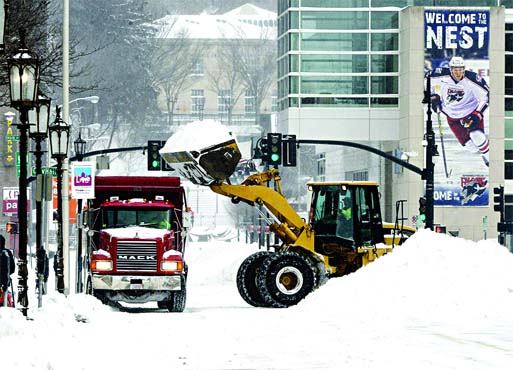
Reuters, New York :
A powerful blizzard struck Boston and surrounding New England on Tuesday, leaving some 4.5 million people grappling with as much as three feet of snow and coastal flooding but sparing New York City residents who had braced for a significant blast.
Snow was forecast to keep falling into early Wednesday in eastern New England, possibly setting a record snowfall in Boston. At Logan International Airport, 23.3 inches (59.2 cm) of snow was on the ground early evening, swept higher in parts by strong winds. “There are drifts now of four, five and six feet in some places,” Massachusetts Governor Charlie Baker said. “This is clearly a very big storm for most of Massachusetts.”
A statewide travel ban was scheduled to be lifted at midnight but Massachusetts residents were urged to stay off the roads if possible.
Boston-area trains, buses and subways were set to resume normal service on Wednesday but delays were predicted for the morning commute. On the resort island of Nantucket, more than half of homes and businesses were still without power at early evening, and crews working to restore electricity were at times getting stuck on roads throughout the day, Police Chief William Pittman said. Lacking electricity and heat at home, more than 100 people flocked to a shelter at a high school and others simply warmed themselves in their running cars, Pittman said.
“We are going to have another tough night ahead of us,” Pittman said, citing fresh snowfall and blustery conditions as well as downed trees and power lines, and icy water over roadways. “After midnight, things are going to start improving.” Icy flooding closed the island’s downtown waterfront, white-out conditions forced some roads to be shut down and ferry and plane service was cancelled, according to local reports. Storm-driven coastal flooding added to the state’s woes, as low-lying towns south of Boston grappled with rising water. High tides breached a seawall in Marshfield, about 30 miles (50 km) south of Boston, damaging 11 homes, several of which were condemned, police said. Police urged residents to evacuate.
Denise Gorham, 57, said she watched a heavy wooden shed filled with window air conditioners float away on waters that surrounded the house after the breach. “It’s been horrible. I’ve been here 12 years and we’ve weathered every single storm. It was just like the ocean was on the street itself,” said Gorham, a writer, who was trying to keep warm over her fireplace after the power went out.
Further south, New York, New Jersey and Connecticut escaped the worst of the storm, despite dire predictions by meteorologists and officials. Travel bans in those states were lifted, and New York City’s subway system was restarted after being closed for 10 hours.
“It wasn’t nearly as bad as predicted, but with the wind and snow hitting your face it’s still no picnic,” said Mike Spigarolo, 56, of Milford, Connecticut as he cleared his property with a snowblower.
The heaviest snowfall was recorded outside Boston, with 36 inches (91.4 cm) in Lunenburg, Massachusetts, and 35 inches (88.9 cm) reported in Auburn, according to the National Weather Service.
Some 45,900 customers across the storm-hit region were without power, according to local utilities, with the bulk of the outages on Massachusetts’ Cape Cod and outlying islands. The severe weather claimed the lives of at least two people. Police in Trumbull, Connecticut said an 80-year-old man collapsed while shovelling snow and died on Tuesday at a nearby hospital.
Police said a teenager died late on Monday when he crashed into a lamppost as he was snow-tubing in the New York City suburb of Suffolk County, on the east end of Long Island, which saw more than two feet of snow in places.
New Yorkers were divided on whether Governor Andrew Cuomo and New York City Mayor Bill de Blasio had over-reacted ahead of the storm. Cuomo had ordered a total travel ban on all roads in the southern part of the state, while the subway system closed for the first time in history due to snow. Chris Jones, a clerk at Whole Foods in Manhattan, said he watched in amazement as customers stocked up on hundreds of dollars worth of food after the mayor warned of major snow accumulation.
“He overly exaggerated,” the 22-year-old Jones said. “Everyone said it would be dozens of inches of snow and as you can see, there’s nothing like that. All of that craze for nothing.”
Others were more forgiving.
“They went by what they knew. It’s better to be safe than to underestimate it and people get stuck or hurt,” said Brent Bounds, 46, a New York City psychologist sledding with his two young sons.
Cuomo defended the decisions, saying he favoured “a lean toward safety.” “I have seen the consequences the other way,” he said. “I would rather be in a situation where we say ‘We got lucky.'”
A blizzard warning was cancelled on Tuesday evening for much of Massachusetts but remained in effect for parts of Maine.
Boston’s record snowfall of 27.5 inches (69.85 cm) was set in February 2003.
“Roads will remain snow-covered and slippery … Gusty winds will continue,” the National Weather Service said on its website. “This is a serious life-threatening storm!”
More than 4,700 US flights were cancelled on Tuesday, according to FlightAware.com, with more than 80 percent of scheduled flights at airports in New York, Philadelphia and Boston affected.
The New York Stock Exchange, owned by Intercontinental Exchange Inc (ICE.N), opened as usual. Nasdaq OMX Group (NDAQ.O) and BATS Global Markets had normal operating hours on Tuesday.

